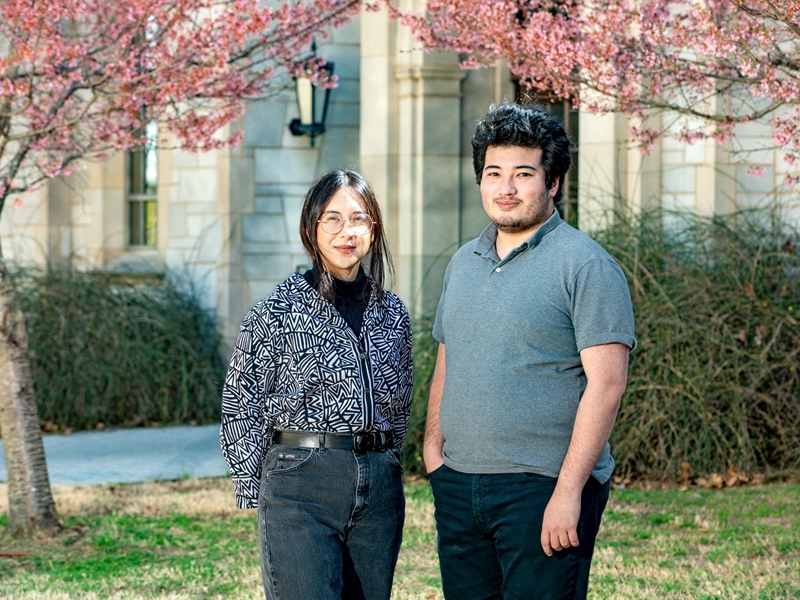
Score another one for artificial intelligence. In a recent study, 151 human participants were pitted against ChatGPT-4 in three tests designed to measure divergent thinking, which is considered to be an indicator of creative thought.
Divergent thinking is characterized by the ability to generate a unique solution to a question that does not have one expected solution, such as “What is the best way to avoid talking about politics with my parents?” In the study, GPT-4 provided more original and elaborate answers than the human participants.
The study, “The current state of artificial intelligence generative language models is more creative than humans on divergent thinking tasks,” was published in Nature’s Scientific Reports and authored by U of A Ph.D. students in psychological science Kent F. Hubert and Kim N. Awa, as well as Darya L. Zabelina, an associate professor of psychological science at the U of A and director of the Mechanisms of Creative Cognition and Attention Lab.
The three tests utilized were the Alternative Use Task, which asks participants to come up with creative uses for everyday objects like a rope or a fork; the Consequences Task, which invites participants to imagine possible outcomes of hypothetical situations, like “what if humans no longer needed sleep?”; and the Divergent Associations Task, which asks participants to generate 10 nouns that are as semantically distant as possible. For instance, there is not much semantic distance between “dog” and “cat” while there is a great deal between words like “cat” and “ontology.”
Answers were evaluated for the number of responses, length of response and semantic difference between words. Ultimately, the authors found that “Overall, GPT-4 was more original and elaborate than humans on each of the divergent thinking tasks, even when controlling for fluency of responses. In other words, GPT-4 demonstrated higher creative potential across an entire battery of divergent thinking tasks.”
This finding does come with some caveats. The authors state, “It is important to note that the measures used in this study are all measures of creative potential, but the involvement in creative activities or achievements are another aspect of measuring a person’s creativity.” The purpose of the study was to examine human-level creative potential, not necessarily people who may have established creative credentials.
Hubert and Awa further note that “AI, unlike humans, does not have agency” and is “dependent on the assistance of a human user. Therefore, the creative potential of AI is in a constant state of stagnation unless prompted.”
Also, the researchers did not evaluate the appropriateness of GPT-4 responses. So while the AI may have provided more responses and more original responses, human participants may have felt they were constrained by their responses needing to be grounded in the real world.
Awa also acknowledged that the human motivation to write elaborate answers may not have been high, and said there are additional questions about “how do you operationalize creativity? Can we really say that using these tests for humans is generalizable to different people? Is it assessing a broad array of creative thinking? So I think it has us critically examining what are the most popular measures of divergent thinking.”
Whether the tests are perfect measures of human creative potential is not really the point. The point is that large language models are rapidly progressing and outperforming humans in ways they have not before. Whether they are a threat to replace human creativity remains to be seen. For now, the authors continue to see “Moving forward, future possibilities of AI acting as a tool of inspiration, as an aid in a person’s creative process or to overcome fixedness is promising.”
About the University of Arkansas: As Arkansas' flagship institution, the U of A provides an internationally competitive education in more than 200 academic programs. Founded in 1871, the U of A contributes more than $2.2 billion to Arkansas’ economy through the teaching of new knowledge and skills, entrepreneurship and job development, discovery through research and creative activity while also providing training for professional disciplines. The Carnegie Foundation classifies the U of A among the few U.S. colleges and universities with the highest level of research activity. U.S. News & World Report ranks the U of A among the top public universities in the nation. See how the U of A works to build a better world at Arkansas Research and Economic Development News.
Topics
Contacts
Kent Hubert, PhD student in experimental psychology
Fulbright College of Arts and Sciences
214-998-2189, khubert@uark.edu
Kim Awa, PhD student in experimental psychology
Fulbright College of Arts and Sciences
214-998-2189, knawa@uark.edu
Hardin Young, assistant director of research communications
University Relations
479-575-6850,
hyoung@uark.edu